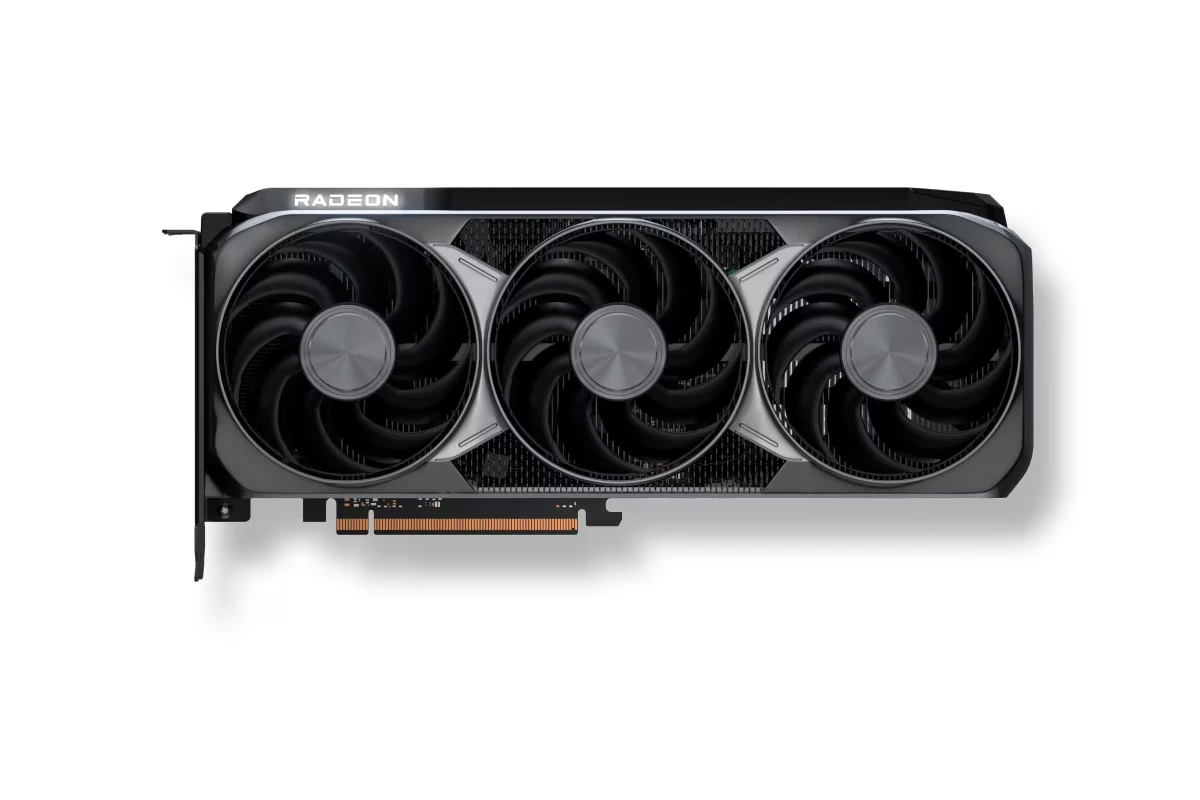Recent benchmark results and data directly from the manufacturer suggest that AMD’s upcoming Radeon RX 9070 XT might offer performance levels that rival NVIDIA’s RTX 5070 Ti, but the reality may be more nuanced. While early tests show mixed results, some leaks indicate near-parity between the two cards, while others suggest that a performance gap still exists. These conflicting benchmarks raise questions about whether AMD’s RDNA 4 architecture can truly match NVIDIA’s latest mid-range offering in all scenarios.
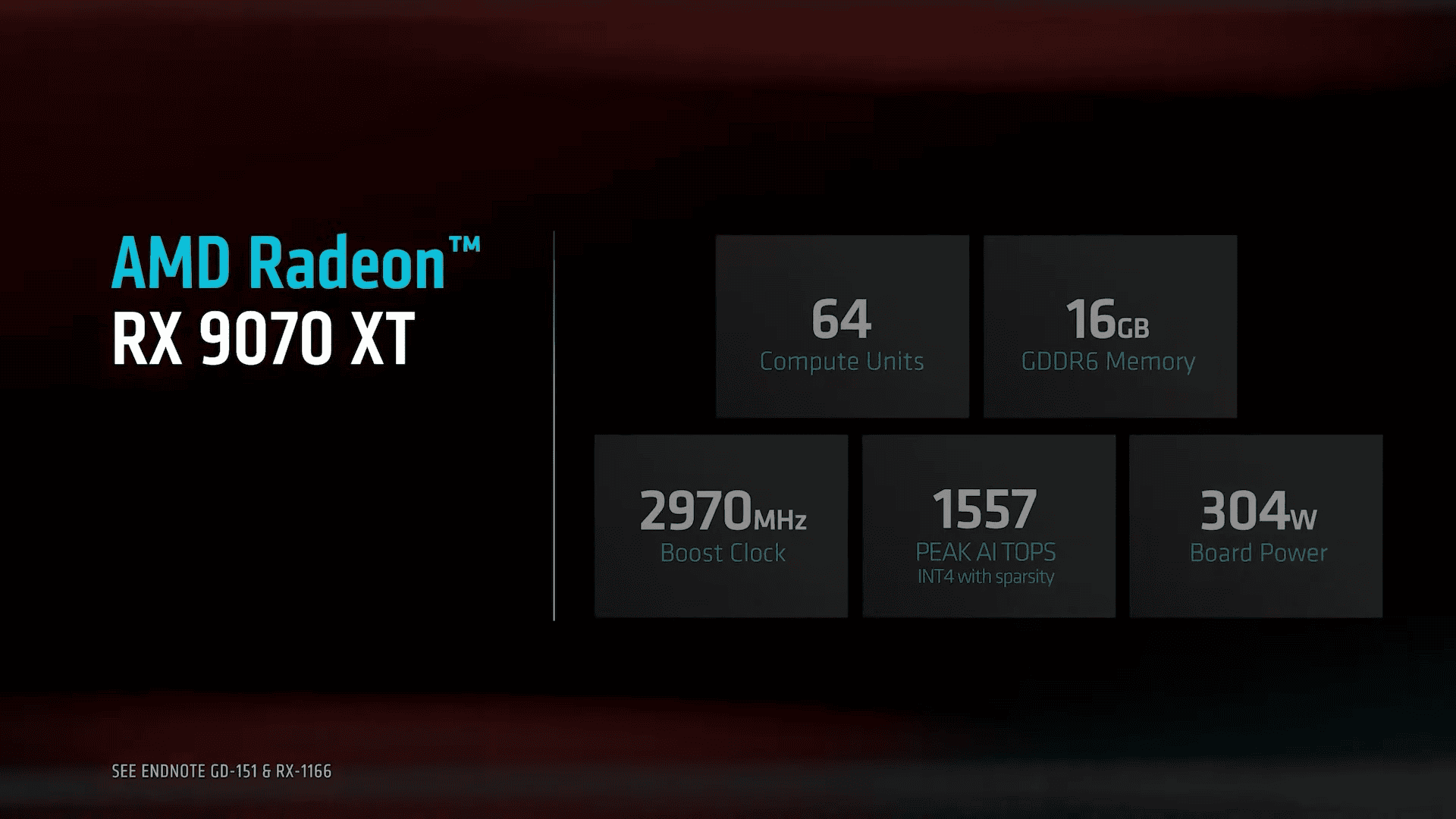
Benchmark Discrepancies: What the Data Tells Us
Unofficial benchmarks indicate that the RX 9070 XT outperforms AMD’s previous RX 7900 GRE by roughly 38-42% at 1440p resolution, putting it firmly in RTX 4070 to RTX 4070 Ti territory. However, comparisons to the RTX 5070 Ti remain inconsistent, as some benchmarks suggest it struggles to keep up with NVIDIA’s next-gen Ada Lovelace Refresh GPU.
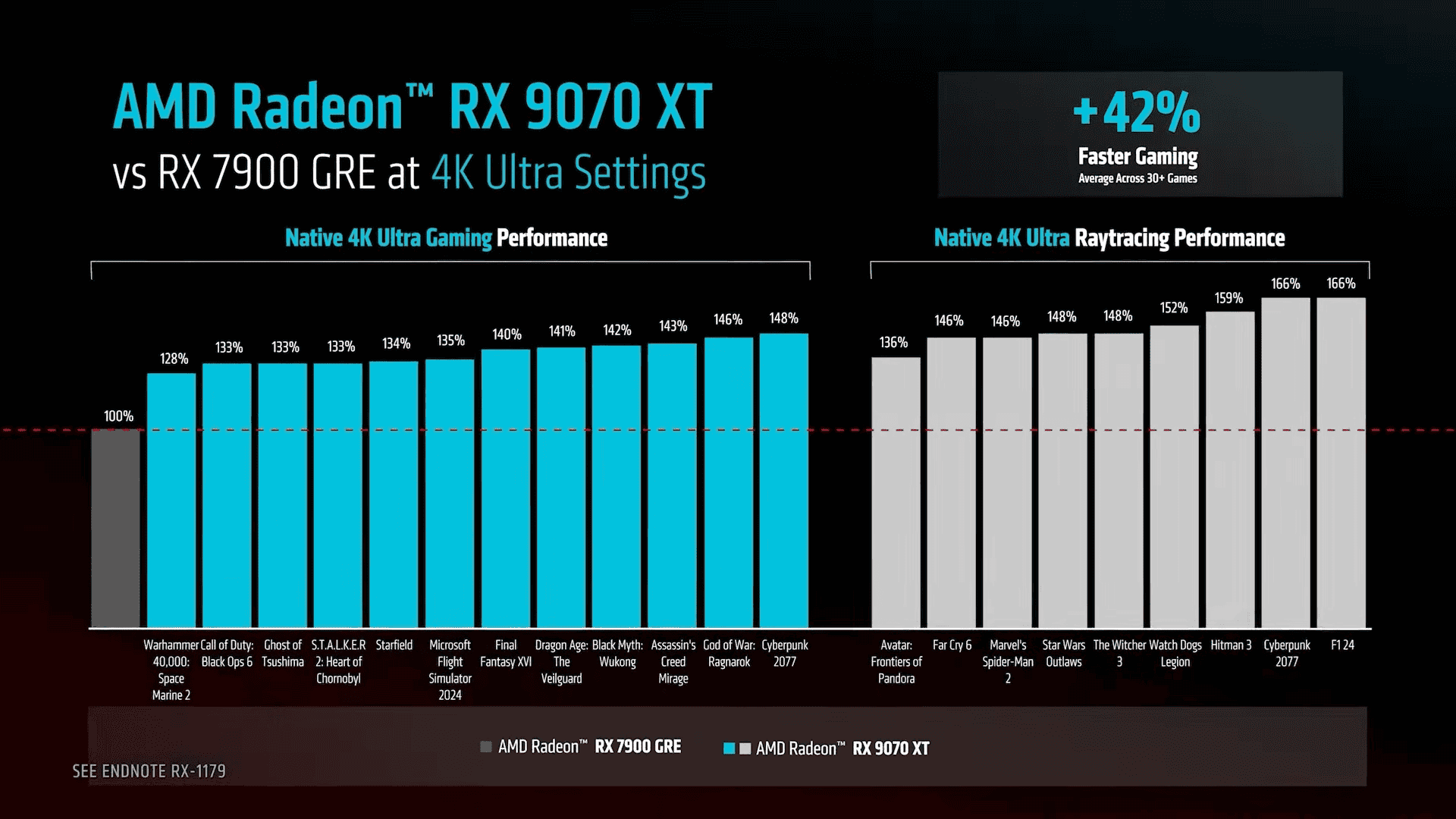
One key factor missing from these early tests is AMD’s upcoming FidelityFX Super Resolution 4 (FSR 4), which could significantly impact performance when enabled. Unlike previous versions, FSR 4 is expected to use AI-driven upscaling techniques similar to NVIDIA’s DLSS 3.5, potentially narrowing the performance gap in real-world gaming scenarios. However, whether FSR 4 can match NVIDIA’s Frame Generation technology remains to be seen.
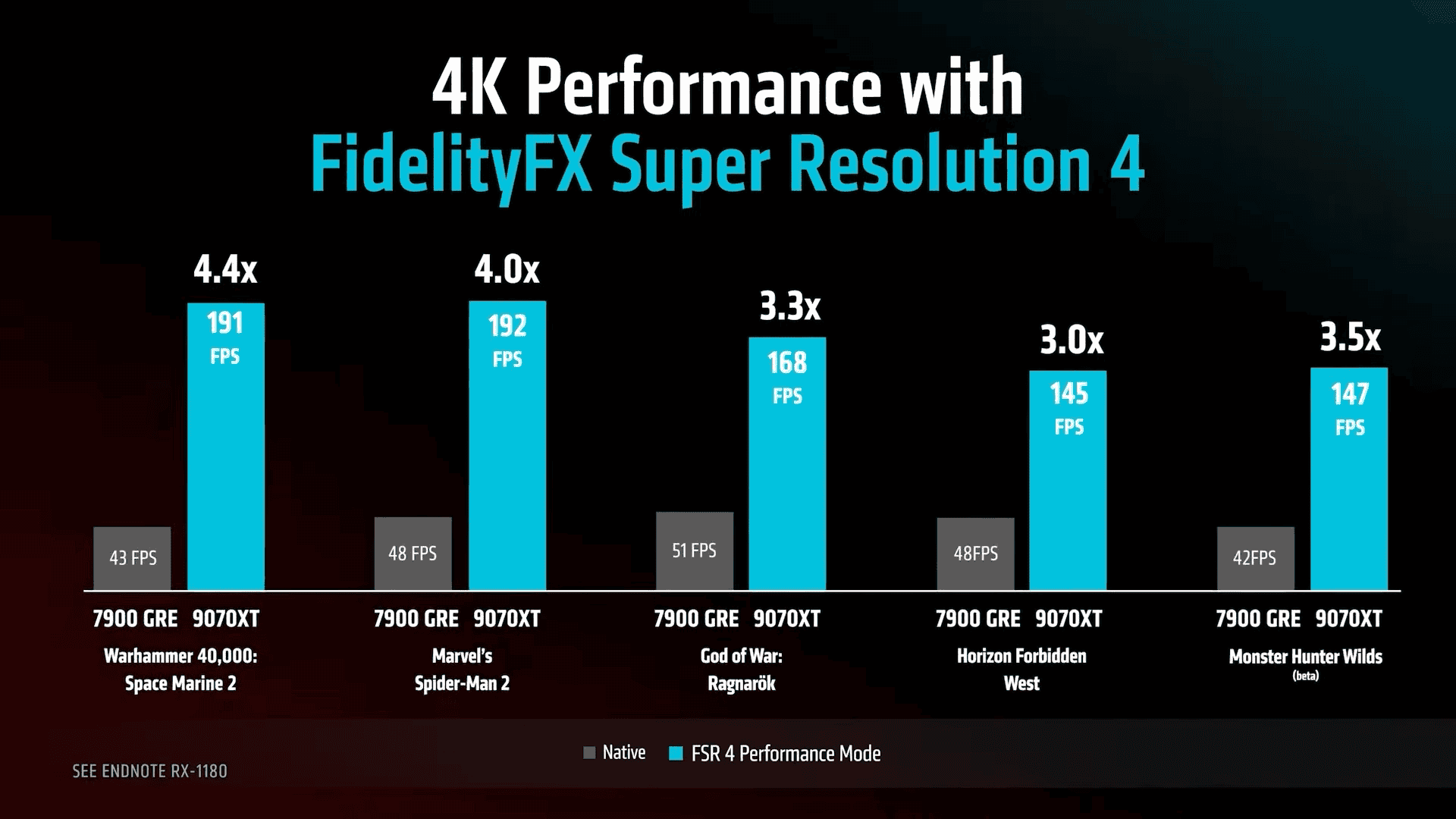
Price-to-Performance: AMD’s Secret Weapon?
While raw performance is critical, AMD has historically relied on aggressive pricing to undercut NVIDIA’s offerings. The RX 9070 XT is rumored to launch at $599, making it $150 cheaper than the expected $749 price tag of the RTX 5070 Ti. This price gap could make the RX 9070 XT a more attractive option for gamers who prioritize traditional rasterization performance over ray tracing.
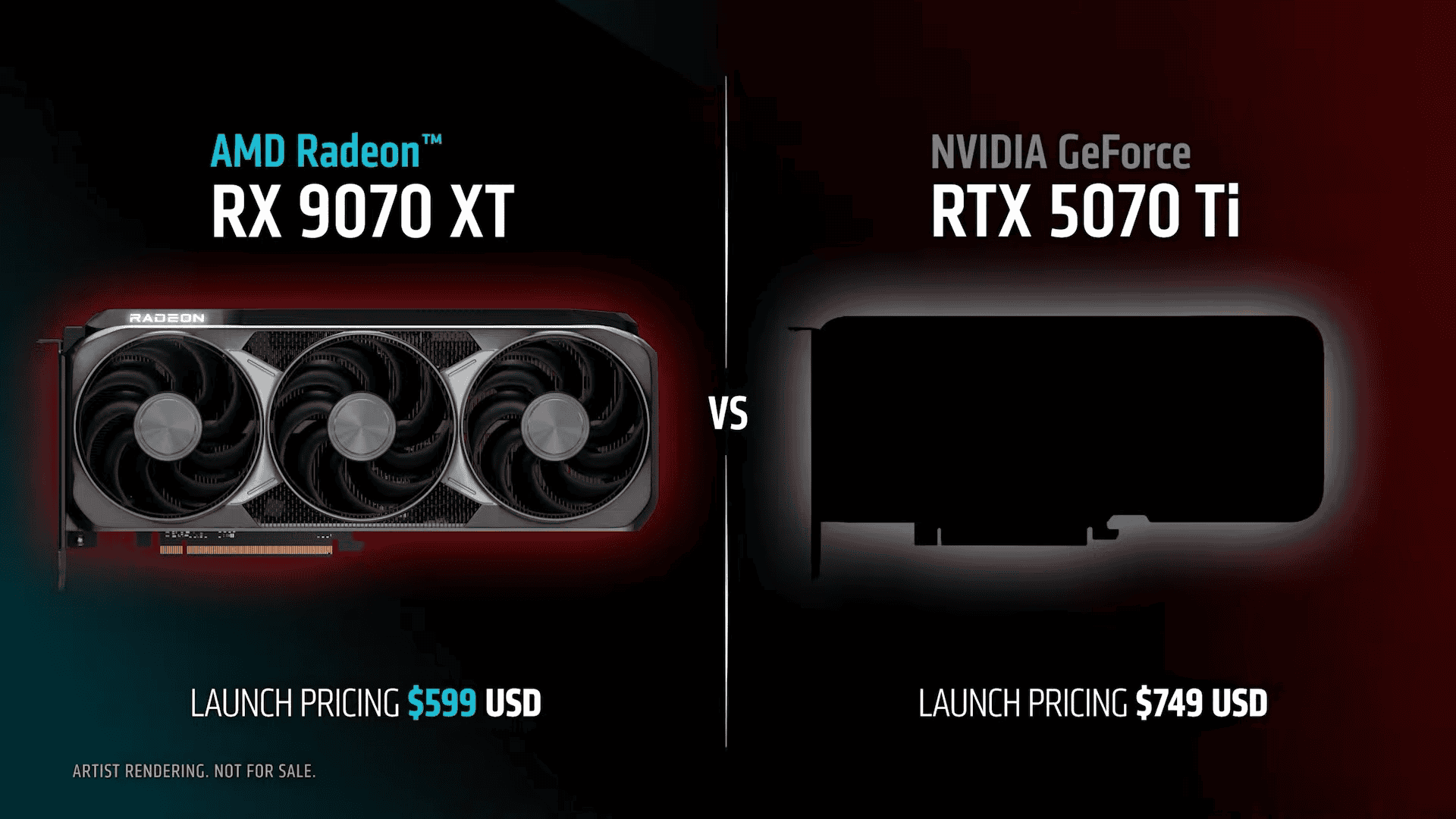
Speaking of ray tracing, NVIDIA still holds a clear lead in RT performance and AI-driven enhancements like DLSS 3.5 and RTX Remix. However, if AMD continues to focus on high refresh rate 1440p gaming and traditional rendering performance, it may offer the best price-to-performance balance for most gamers.
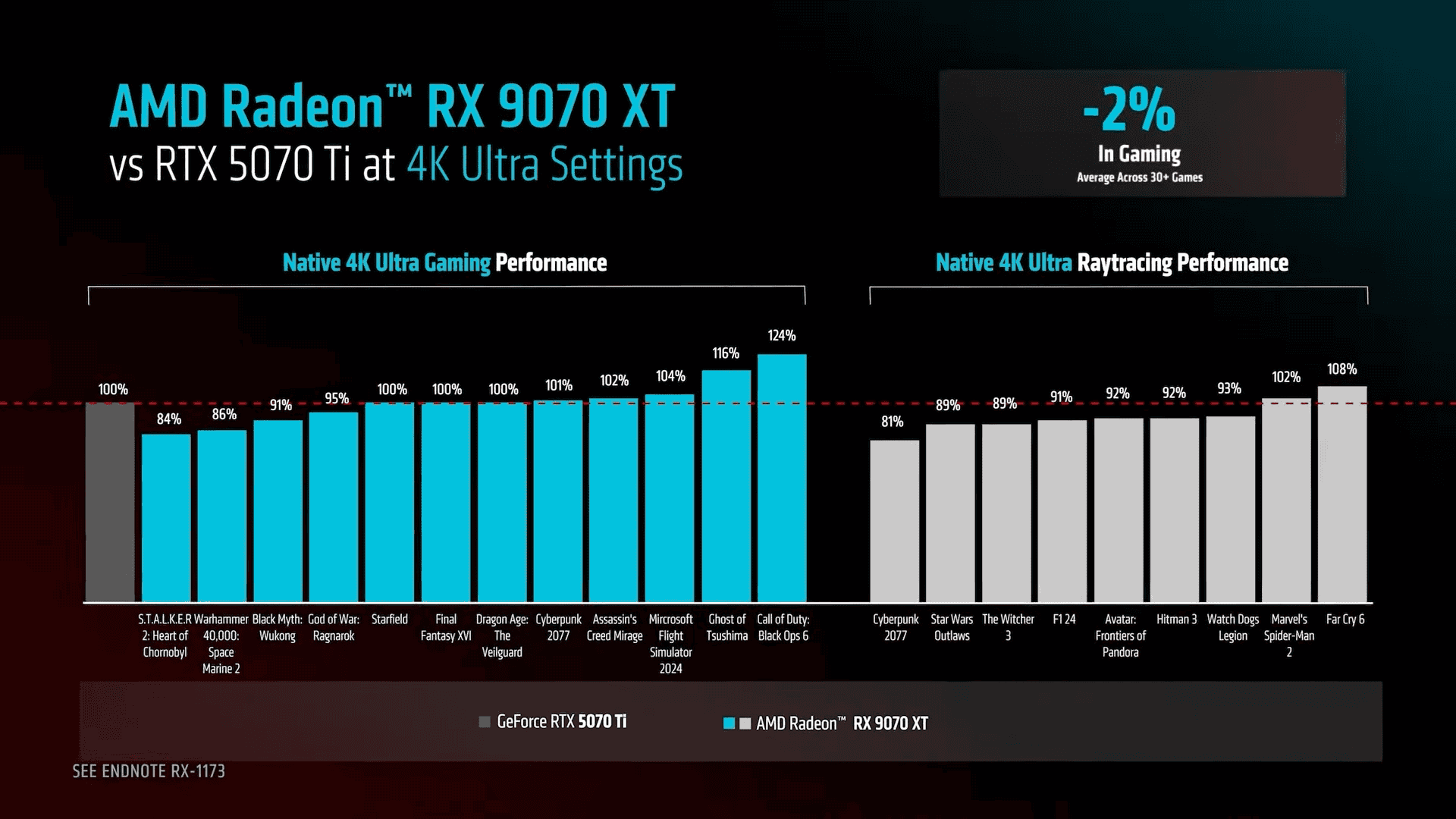
Power Efficiency and Architectural Differences
Another critical aspect to consider is power consumption and efficiency. NVIDIA’s Ada Lovelace Refresh cards have been optimized for better power efficiency, meaning the RTX 5070 Ti is expected to be more power-efficient than AMD’s RDNA 4 GPUs. Leaks suggest that the RX 9070 XT may consume up to 340W in overclocked models, while NVIDIA’s 5070 Ti will likely operate closer to 250-275W. This difference could be a deciding factor for users who are concerned about heat output and energy efficiency.
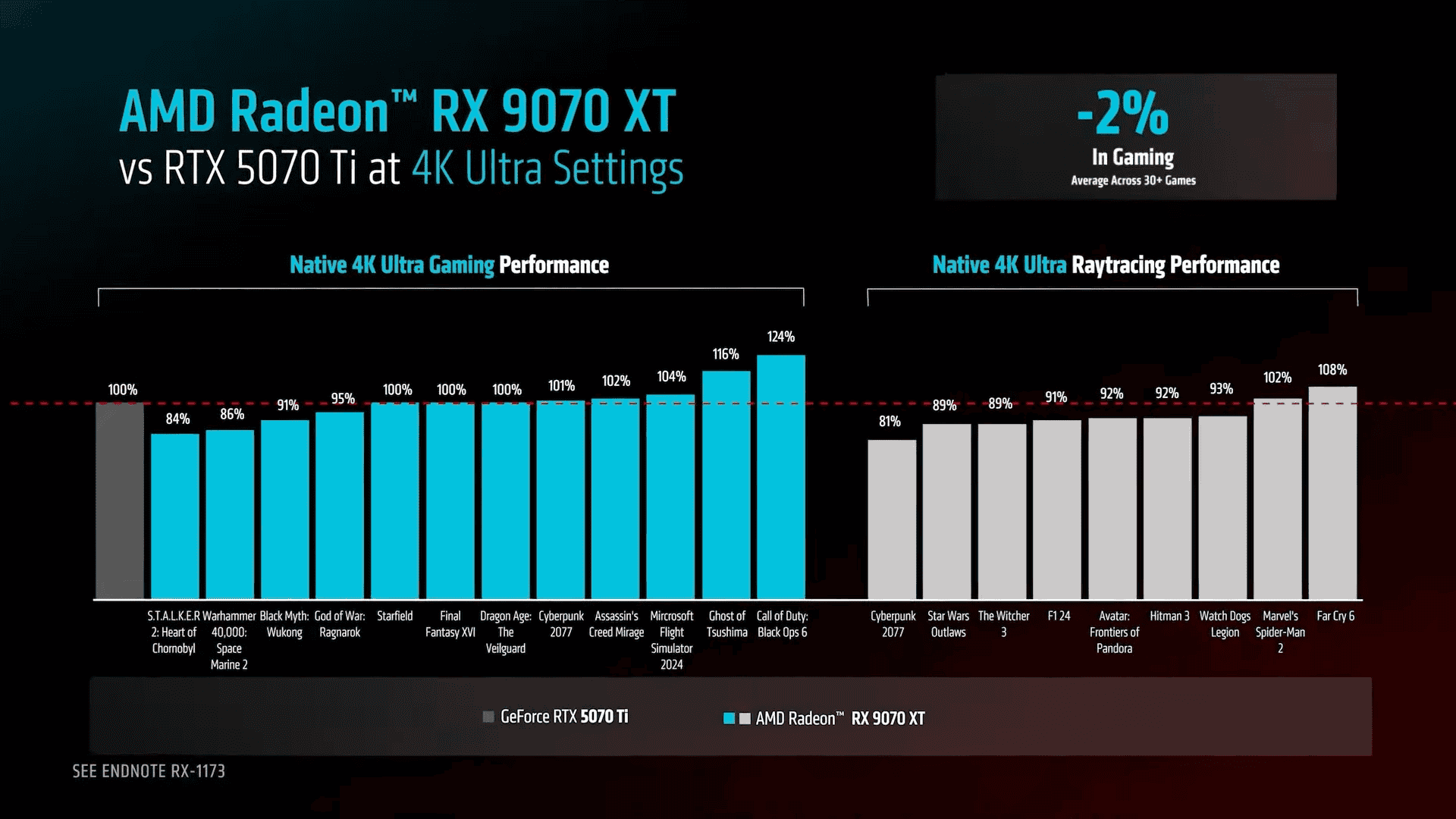
The Verdict: Should You Wait?
The RX 9070 XT’s value proposition will depend on final benchmarks, AMD’s driver optimizations, and FSR 4’s real-world effectiveness. If you’re primarily playing rasterized games at 1440p or 4K, AMD’s offering could be a great alternative at a lower price. However, if you prioritize ray tracing, power efficiency, or AI-driven upscaling, the RTX 5070 Ti might still be the better option.
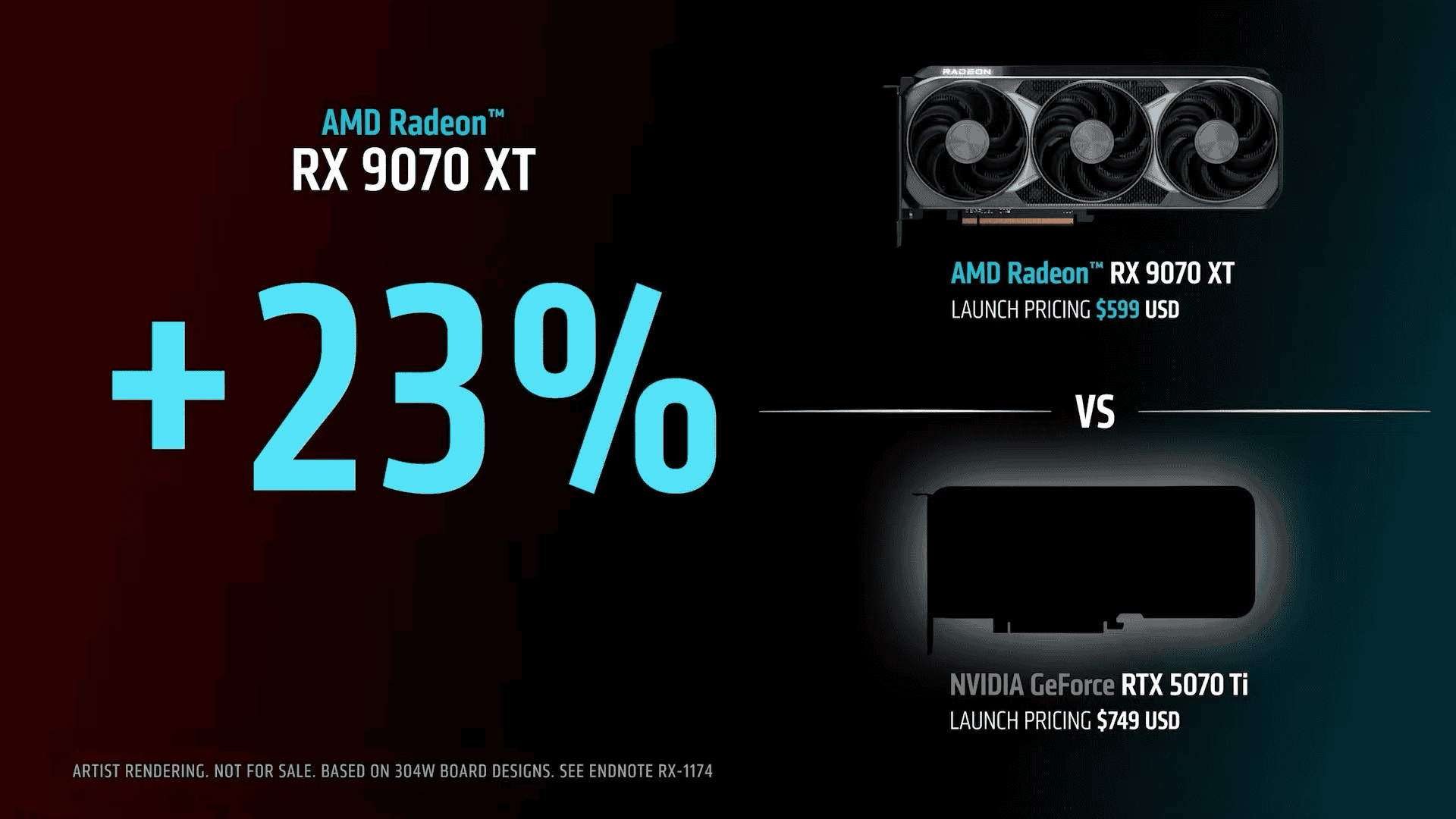
As we approach the March 2025 launch, expect more definitive comparisons, but one thing is clear: AMD is pushing aggressively to challenge NVIDIA in the mid-to-high-end GPU space. If they can iron out software optimizations and deliver on FSR 4’s promise, the RX 9070 XT could become one of the best value GPUs on the market.
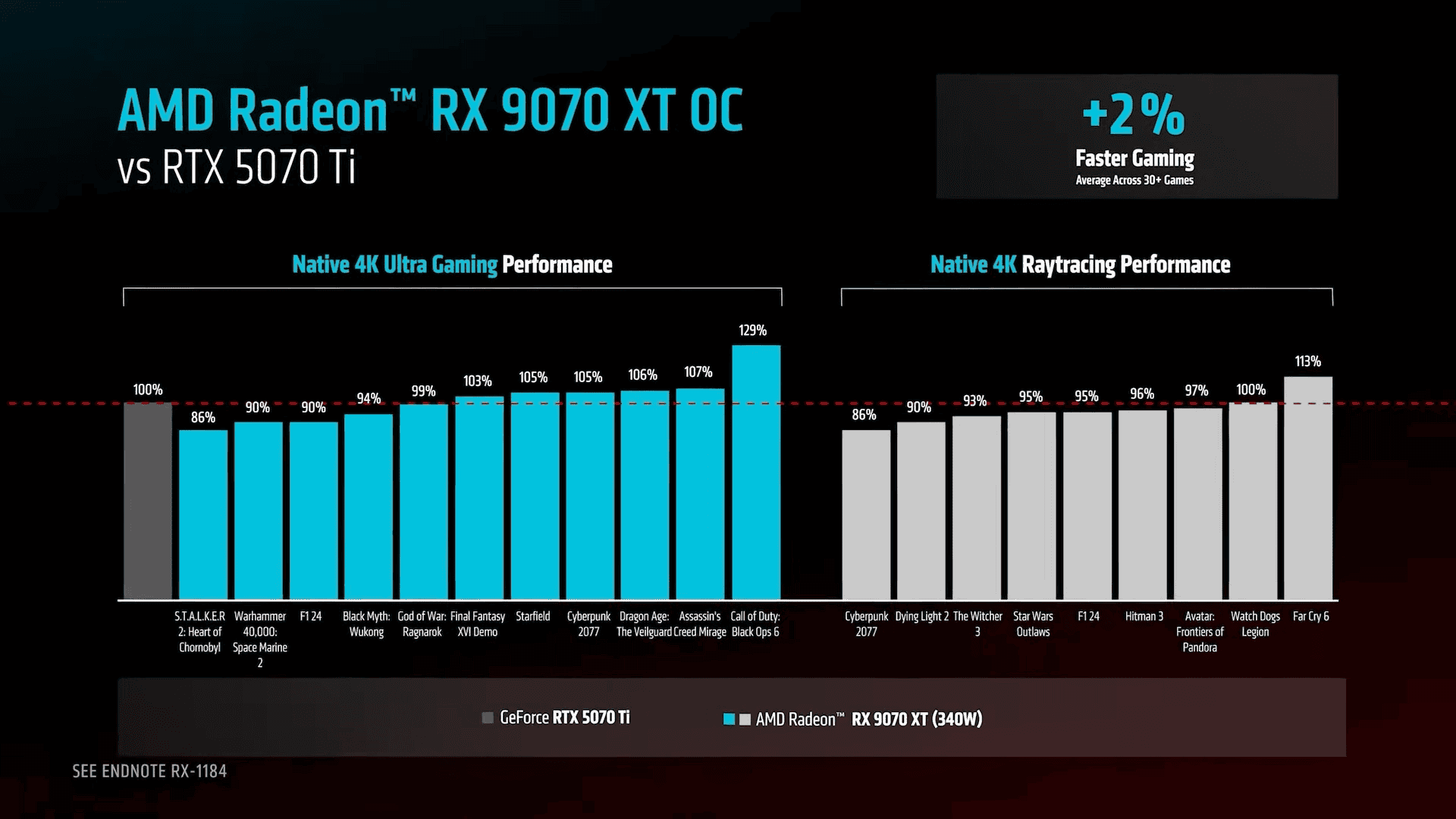
Key Takeaways
- Early benchmarks show the RX 9070 XT performing between RTX 4070 and RTX 5070 Ti levels, with results varying across different tests.
- AMD’s new RDNA 4 architecture delivers significant performance improvements over previous generation cards, with up to 42% gains at 1440p resolution.
- The final performance assessment should account for upcoming technologies like FSR 4 and potential driver optimizations that could improve real-world performance.
Comparative Analysis of AMD Radeon RX 9070 XT and NVIDIA RTX 5070 Ti
The AMD Radeon RX 9070 XT and NVIDIA RTX 5070 Ti represent the latest mid-to-high-end offerings from the two GPU giants. Recent benchmarks suggest these cards may deliver similar performance despite their architectural differences.
Specifications and Architecture
The RX 9070 XT features approximately 4,096 shader units based on AMD’s RDNA 4 architecture and Navi 48 chip. It includes around 64 ray tracing cores for handling ray-traced lighting effects. The card launched in January 2025 with a price tag of $749.
NVIDIA’s RTX 5070 Ti comes equipped with 8,960 CUDA cores and 70 fourth-generation RT cores dedicated to ray tracing tasks. The RTX 5070 Ti also launched in January 2025 but at a lower MSRP of $549, making it more budget-friendly.
Both cards feature high-speed VRAM, though they differ in implementation. The architectural approaches diverge significantly, with NVIDIA continuing its focus on AI acceleration through dedicated Tensor cores—a feature absent in AMD’s design.
Clock speeds for both GPUs run in similar ranges, though the exact specifications continue to be refined through driver updates.
Performance Metrics in Benchmarking
Recent leaked benchmarks suggest the RX 9070 XT performs roughly on par with the RTX 5070 Ti in many scenarios. Some tests indicate the AMD card may be about 22% slower than NVIDIA’s offering, though this varies by application.
Interestingly, other benchmark leaks suggest the RX 9070 XT might match the previous-generation RTX 4080 in raw performance. This points to significant generational improvements for AMD.
Geekbench results show competitive scores between both cards, though NVIDIA tends to pull ahead in tests heavily utilizing AI acceleration. AMD maintains stronger performance in traditional rasterization workloads.
| Benchmark | RX 9070 XT | RTX 5070 Ti |
|---|---|---|
| 3DMark | Competitive | Slight lead |
| Geekbench | Strong | Strong |
| Ray tracing | Good | Excellent |
Gaming Performance Comparison
In gaming scenarios, both cards deliver excellent frame rates at 1440p resolution. At 1080p, they frequently exceed 100 FPS in demanding titles, making either choice suitable for high-refresh-rate gaming.
Cyberpunk 2077 serves as a good benchmark for modern gaming performance. With ray tracing disabled, both cards deliver similar frame rates. With ray tracing enabled, NVIDIA’s card takes a modest lead due to its specialized RT cores.
At 1440p resolution, most AAA titles remain comfortably playable on both GPUs. The RX 9070 XT shows particularly strong performance in titles optimized for AMD hardware, while the RTX 5070 Ti excels in games utilizing DLSS technology.
Game engines utilizing DirectX 12 or Vulkan APIs show the smallest performance gap between these cards. Older titles or those using DirectX 11 tend to favor NVIDIA’s architecture slightly.
Technological Advances in Radeon RDNA 4 GPUs
AMD’s RDNA 4 architecture introduces significant technological improvements that enhance performance and efficiency in the new Radeon RX 9000 series. The upcoming February 28, 2025 launch promises to deliver competitive options against NVIDIA’s latest offerings.
Innovations in RDNA 4 Architecture
RDNA 4 features a redesigned compute unit structure that maximizes throughput while reducing power consumption. AMD has increased the number of compute units in the RX 9070 XT compared to previous generations, improving parallel processing capabilities.
The architecture incorporates new AI accelerators specifically designed to enhance game performance through smart resource allocation. These accelerators power the improved FSR 4 upscaling technology, which uses machine learning algorithms to deliver near-native resolution quality with minimal performance impact.
Ray tracing performance sees substantial improvements with dedicated hardware that processes light calculations more efficiently. Early benchmark leaks suggest up to 50% better ray tracing performance compared to the RX 7000 series.
Power efficiency has been prioritized with refined voltage curve optimization and more granular power states. This allows the GPUs to maintain higher clock speeds under load while staying within reasonable thermal limits.
Comparison with Previous Generations
The RX 9070 XT demonstrates approximately 35% performance improvement over the 7900 XT in rasterization workloads based on early testing data. This generational leap is particularly noticeable in compute-heavy applications and modern games using advanced rendering techniques.
Memory bandwidth has increased significantly with the implementation of faster GDDR7 memory on the 9070 series. This addresses a previous bottleneck in the RDNA 3 architecture where memory constraints limited performance in high-resolution gaming scenarios.
Thermal design has been refined with an improved vapor chamber cooling system that maintains lower temperatures under sustained loads. The RX 9070 XT runs approximately 8°C cooler than its predecessor while delivering higher performance.
The die size has been reduced by about 20% through the use of advanced manufacturing processes, leading to better yields and potentially more competitive pricing. This efficiency improvement allows AMD to deliver more performance per watt than any previous Radeon generation.
Price-to-Performance Analysis
When comparing AMD’s Radeon 9070 XT to NVIDIA’s RTX 5070 Ti, the value proposition becomes a critical factor for buyers looking beyond raw performance numbers. Price efficiency and strategic positioning in the market will determine which card offers better overall value.
Cost Efficiency for Consumers
Based on leaked information from Micro Center, the RX 9070 XT is expected to launch at a price point close to $749, which is nearly identical to the RTX 5070 Ti’s MSRP. The standard RX 9070 appears to be positioned at a higher price than initially anticipated.
For rasterization performance, the 9070 XT offers comparable results to the RTX 5070 Ti while potentially costing the same. This creates a balanced choice for gamers who prioritize traditional rendering.
Ray tracing performance presents a different story. The 9070 XT likely falls behind NVIDIA’s offering in this specialized workload, making the RTX 5070 Ti a better value for those who frequently use ray-traced games.
Compared to previous generations, both new cards represent significant jumps. The 9070 XT delivers up to 42% better performance than AMD’s 7900 GRE at 4K resolution, according to AMD’s internal benchmarks.
Market Positioning
AMD appears to be directly challenging NVIDIA’s mid-to-high-end segment with the 9070 series. The performance improvements over the previous 7900 GRE and 6900 XT models position these cards as solid upgrades for existing AMD users.
The standard RX 9070 shows a 21% improvement over the 7900 GRE in 4K gaming scenarios. This places it in competition with NVIDIA’s RTX 4070 Super rather than the newer 5000-series cards.
NVIDIA maintains an advantage in additional features like DLSS and superior ray tracing. These technologies may justify the similar pricing despite AMD’s efforts to close the gap.
Market reception will likely depend on real-world availability and pricing stabilization after launch. If AMD can maintain steady supply and competitive pricing, the 9070 XT could represent a viable alternative to NVIDIA’s offerings in the $700-$800 price bracket.
Feature Assessment and Real-World Application
The AMD Radeon 9070 XT presents a competitive package against Nvidia’s RTX 5070 Ti with comparable benchmark results. While raw performance numbers show similar capabilities, the real value proposition comes from examining specific features and how they translate to actual usage scenarios.
Ray Tracing and Raster Performance
AMD’s approach to ray tracing has evolved significantly with the RDNA 4 architecture. The RX 9070 XT delivers impressive raster performance with leaked benchmarks showing it outperforming the previous generation RX 7900 GRE by up to 42% at 4K resolution with ultra settings. This represents a substantial generational leap.
Ray tracing performance, historically a weakness for AMD, appears to have narrowed the gap with Nvidia. The 9070 XT handles ray-traced lighting effects with improved efficiency compared to previous generations. However, Nvidia’s RTX 5070 Ti still maintains a slight edge in pure ray tracing workloads.
FSR 4 (FidelityFX Super Resolution) complements the 9070 XT’s capabilities by delivering frame rate boosts in supported titles. This technology helps maintain smooth gameplay even with demanding ray tracing effects enabled.
Enhancements in Cooling Solutions
Thermal management has received significant attention in the RX 9070 XT design. The card implements a revised cooling architecture with improved heat dissipation compared to previous RDNA generations.
The reference design features a dual-fan configuration with a vapor chamber and optimized fin stack. This design helps maintain consistent clock speeds under load without excessive noise generation.
Board partners are expected to offer custom cooling solutions with triple-fan designs and enhanced heatsinks. These variants should appeal to overclockers and users in warmer environments where thermal throttling could become an issue.
Power efficiency has improved with RDNA 4, resulting in lower heat output per performance unit. This allows for more compact cooling solutions without sacrificing thermal performance.
Driver Support and Optimization
AMD’s driver ecosystem continues to mature with the RX 9070 XT. The Adrenalin software suite provides a comprehensive set of tools for monitoring, overclocking, and optimizing gaming performance.
Day-one driver support for major game releases has improved substantially. AMD has dedicated resources to ensuring timely optimizations for popular titles, reducing the performance gap often seen immediately after game launches.
Smart Access Memory (SAM) technology, when paired with compatible AMD processors, delivers additional performance gains in certain titles. This feature leverages the full GPU memory bandwidth potential.
The RX 9070 XT benefits from AMD’s ongoing refinement of its upscaling technology. FSR integration in the driver allows for application even in games without native support, providing performance benefits across a wider range of titles.
Memory and Resolution Capabilities
The AMD Radeon RX 9070 XT comes equipped with robust memory specifications that position it as a strong competitor to NVIDIA’s RTX 5070 Ti. Memory capacity and bandwidth directly influence how these cards handle different gaming resolutions.
GDDR6 Memory Analysis
The Radeon RX 9070 XT features 16GB of GDDR6 memory according to the leaked specifications. This generous VRAM allocation provides ample headroom for modern gaming titles with high-resolution textures. The memory runs on a 256-bit bus, offering sufficient bandwidth for demanding applications.
Memory speed appears to be optimized for both power efficiency and performance. Compared to the RTX 5070 Ti, AMD’s solution provides a comparable memory configuration. This parity ensures that neither card has a significant advantage when it comes to texture loading or handling large game assets.
The additional VRAM capacity may benefit users who run memory-intensive applications or play games at higher resolutions with texture-heavy settings.
Performance at Different Resolutions
At 1080p resolution, both the RX 9070 XT and RTX 5070 Ti deliver exceptional framerates that exceed the refresh rates of most gaming monitors. This makes either card somewhat overpowered for pure 1080p gaming unless paired with high refresh rate displays.
The 1440p performance is where these cards truly shine. According to AMD’s testing data, the RX 9070 XT performs 42-168% faster than the previous Radeon RX 7900 GRE at 4K resolution with ultra quality settings. This suggests excellent 1440p performance as well.
For 4K gaming, leaked data positions the RX 9070 XT as a direct competitor to NVIDIA’s offerings. AMD’s testing methodology focused on native rendering rather than upscaling technologies, highlighting the card’s raw performance capabilities at higher resolutions.
Anticipated Developments in GPU Technology
GPU technology continues to evolve rapidly with both AMD and NVIDIA pushing boundaries in performance and efficiency. The coming months will reveal significant shifts in the competitive landscape as new architectures mature and reach consumer markets.
Implications from CES 2025
CES 2025 showcased AMD’s commitment to challenging NVIDIA’s dominance with their RDNA 4 architecture. The RX 9070 XT featured prominently in AMD’s presentations, with early benchmark results suggesting performance comparable to the RTX 4080 in raster workloads.
AMD did not directly compare their RX 9070 XT to NVIDIA’s RTX 5070 Ti during the event. This strategic omission was explained as due to “lack of access to the card” rather than competitive concerns.
The focus at CES turned to efficiency metrics, with AMD highlighting the performance-per-watt improvements in their newest GPUs. This approach aligns with the growing consumer interest in power consumption alongside raw performance numbers.
The Future of AMD and NVIDIA GPUs
AMD’s CEO confirmed a March release window for both the RX 9070 XT and standard RX 9070. These cards will feature 16GB of VRAM, positioning them as strong alternatives to NVIDIA’s offerings in the high-performance segment.
The competitive landscape will likely intensify as NVIDIA continues its rollout of the RTX 50 series. The recently launched RTX 5070 Ti has set new performance standards that AMD will need to address.
Benchmark leaks suggest the RX 9070 XT currently trails the RTX 5070 Ti by approximately 22% in some tests. However, AMD’s focus on value may still make their offerings attractive to consumers.
Both companies appear to be placing greater emphasis on AI acceleration capabilities in their upcoming releases. This trend reflects the growing importance of machine learning in gaming and content creation applications.
Frequently Asked Questions
AMD’s Radeon 9070 XT brings impressive specifications to compete with Nvidia’s RTX 5070 series graphics cards. The leaked benchmarks and specifications reveal interesting performance metrics and architectural differences between these two powerful GPUs.
How does the AMD Radeon 9070 XT’s performance compare to its Nvidia counterparts?
According to leaked benchmark results, the AMD Radeon 9070 XT seems to perform on par with the Nvidia RTX 4070 in most tests. The card appears to match the RTX 4070 Super in some scenarios, making it a competitive option in this performance tier.
However, the RX 9070 XT reportedly runs about 22% slower than Nvidia’s RTX 5070 Ti. This performance gap is significant but not unexpected given the architectural differences between AMD and Nvidia GPUs.
What are the expected benchmark results for the AMD Radeon 9070 XT?
Leaked benchmarks show the RX 9070 XT performing well in games like Black Myth Wukong and Cyberpunk 2077 across multiple resolutions including 1080p, 1440p, and 2160p. The card was reportedly tested alongside Nvidia’s RTX 4080 Super and RTX 4070 Ti Super for comparison.
The card’s 4,096 shaders and 16GB of VRAM running at 20 Gbps contribute to its strong performance profile. The GPU also supports PCIe 5.0, giving it access to improved bandwidth for data transfer.
Can the AMD Radeon 9070 XT match the RTX 5070 Ti in terms of gaming performance?
Based on current information, the RX 9070 XT doesn’t quite match the RTX 5070 Ti in raw gaming performance. The benchmarks suggest it runs approximately 22% slower than Nvidia’s offering.
However, AMD’s FSR 4 technology, which is exclusive to the RX 9000 series, could potentially narrow this gap in games that support this upscaling technology. This feature wasn’t incorporated in the leaked benchmark tests.
What are the key differences in architecture between the AMD Radeon 9070 XT and the RTX 5070 Ti?
The AMD Radeon RX 9070 XT comes equipped with 4,096 shaders and 16GB of VRAM, while the RTX 5070 is reported to have 6,144 shaders but only 12GB of VRAM. This highlights AMD’s focus on memory capacity versus Nvidia’s emphasis on shader count.
Another key difference is the memory bandwidth. The RX 9070 XT features 20 Gbps memory, which may provide advantages in memory-intensive workloads.
The RX 9070 XT also supports PCIe 5.0, ensuring compatibility with the latest motherboards and potentially better data transfer rates.
How does ray tracing performance differ between the AMD Radeon 9070 XT and the RTX 5070 Ti?
Ray tracing performance continues to be an area where Nvidia holds an advantage. Preliminary benchmarks suggest the RX 9070 XT might not match the RTX 5070 Ti in ray tracing performance, which has historically been a stronger point for Nvidia’s RTX series.
AMD has made strides in ray tracing with each generation, but the architecture in Nvidia GPUs remains more optimized for these specific workloads. The RTX 5070 Ti benefits from Nvidia’s more mature ray tracing implementation.
What is the power efficiency comparison between the AMD Radeon 9070 XT and the RTX 5070 Ti?
While specific power consumption figures weren’t detailed in the leaked benchmarks, AMD’s RX 9070 XT is expected to feature a high clock speed of around 3.1 GHz. This suggests the card may consume considerable power during peak performance.
Nvidia’s cards have traditionally held an edge in power efficiency, and the RTX 5070 Ti likely continues this trend with its newer architecture. The actual efficiency difference will become clearer once both cards are officially released and thoroughly tested.
Power consumption will be an important consideration for users with limited power supplies or those concerned about energy costs and thermal output in their systems.

